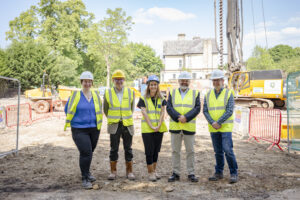
Joanne Merry, technical director at Carbon 2018, discusses why is a wellbeing strategy is vital for property managers.
Florence Nightingale told hospitals that they needed more windows, better ventilation, improved drainage and more space. This was great advice in the early days of better, healthier buildings but today the challenges are far greater.
Employers are pushing for healthier, more comfortable working environments for their staff, which has made those in the property management sector alive to the need for a wellbeing strategy for their buildings.
The healthy building movement
There are two main drivers of the healthy building movement. The first is the clear evidence that the working environment impacts employee productivity, providing employers with a financial case for being concerned about workplace wellbeing.
The second is that the next generation of employees, Generation Z, are not willing to compromise on health or happiness and demand nothing less than a work environment where wellbeing matters. For employers to attract, and keep, the best talent, a healthy building is a must.
Property managers who are proactive about wellbeing in their buildings are more likely to attract new tenants, as many organisations now consider lifestyle and wellbeing factors when selecting offices.
Even property managers who have existing tenants and are not looking for new ones cannot ignore it. If they do, there is a risk that their tenants will question their management stance and force wellbeing to be considered and acted upon in a more reactive way. At worst they will look for new offices.
It is likely to become common practice in the near future for property managers to have a separate wellbeing policy for their buildings. Elements of wellbeing are already addressed in existing policies such as health and safety and sustainability, but these do not typically take a holistic view, nor do they go far enough.
There are a number of voluntary wellbeing standards for properties that are emerging, similar to those we have seen for energy and sustainability. These allow property managers to go above and beyond the minimum requirements and demonstrate their commitment to the cause.
Property managers should also consider that as smart technology continues to evolve, they could find themselves being held to account by their occupiers. This is because, in the future, wearable technologies like smart watches may be able to tell us about environmental wellbeing factors such as air quality, lighting, humidity and noise levels.
Since we already have devices that track personal wellbeing parameters such as blood pressure, steps and sleep patterns, it seems natural that interest will soon turn to measuring the quality of our environment. When that happens, property managers will need to make sure that their buildings conform to the wellbeing standards their occupiers expect.
It is clear that having a wellbeing strategy in place is essential for successful property management. The next question is how should managers approach developing one and what factors should they consider?
Understanding the building and its stakeholders
A wellbeing strategy will vary from building to building, taking account of its location, age and type, the systems it has installed, and the nature and purpose of its occupiers. The first step towards developing a positive and proactive strategy will be to understand the demands and goals of the building and all those who have a stake in it.
Engaging with occupiers to understand their motivations, rather than making assumptions about them, will go a long way towards achieving the very objectives a wellbeing strategy sets out to meet. At the same time, understanding the physical, technical, geographical and economical constraints of the building will dictate which wellbeing measures are possible and which are not.
Defining wellbeing responsibilities
Once the constraints and objectives of the building and its stakeholders are understood, property managers will need to consider the different areas of responsibility that can be defined by a wellbeing policy.
They themselves will be responsible for the common parts of the building and its central services, ensuring appropriate levels of thermal comfort, lighting and air quality. Tenants, too, will have their own responsibilities within their demised space; it will be up to them to focus on the functional and physiological aspects that affect the day-to-day work life of their staff.
Then there are third parties such as onsite maintenance teams and contractors. A wellbeing policy will need to be concerned with the impact of their activities on occupants’ wellbeing. It is likely that we will see health and safety risk assessments evolve to look at softer wellbeing factors such as noise, air quality and smell.
Once roles and responsibilities are understood, targets and actions can be set for the different parties involved to support the policy objectives.
Gathering extra data and putting it to good use
Increased gathering and monitoring of data will be necessary to make sure the standards in a wellbeing policy are being met. Building management systems and energy meters already collect a wealth of data but it is likely that systems will be extended to cover wellbeing parameters such as air quality, CO2 and lighting levels.
But wellbeing is not only about numbers. Its very nature will require the collection of qualitative data on the feelings and perceptions of occupiers as well. This qualitative data, which can be gathered via occupier satisfaction surveys, will need reviewing against the objectives and standards set out in the policy.
It is also important to remember that monitoring and maintaining performance against the policy standards is only half the battle. The other half is using the data to make adjustments to the policy itself.
Wellbeing is not as black and white as health and safety and managers should be aware that objectives will evolve more quickly in the course of making buildings more comfortable places. Wellbeing policies should be fluid enough to allow for continual improvement.
New builds versus existing buildings
A final consideration is that developing a wellbeing strategy for a new build is typically very different to developing one for an existing building. With existing buildings, property managers have to work within the confines of what is physically feasible and economically viable.
With new builds, wellbeing measures are increasingly considered and integrated at the design stage with a view to meeting future tenant needs. In many cases, it will be easier to develop a wellbeing policy for a new build because half the work is already done.


















Leave a Reply